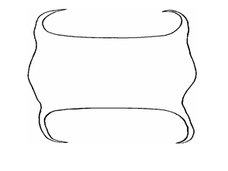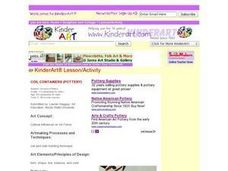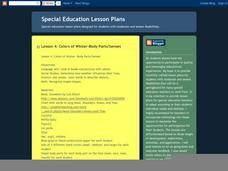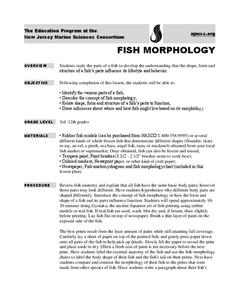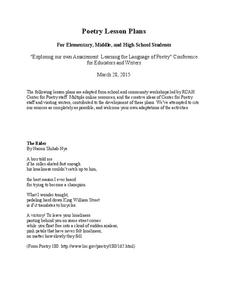Curated OER
Skates
Students gain understanding of structure, characteristics, and basic needs of living things and their role in world, identify parts of skate, observe details of skate's body and skate egg case, and identify unique characteristics of skates.
Curated OER
Modeling the Electromagnetic Spectrum
Learners construct a model of an electromagnetic spectrum using play-doh and string. They use exponents and plot the radio/microwave, infrared, and visible bandwidths of the spectrum.
Curated OER
Wipe Out
Learners examine the flow of water. They observe and test the properties of water by using sticks in flowing water. The lesson has streaming video, resource links to access, and a good hands-on activity that is clearly described in the...
Curated OER
Don't Let the Earth Down
Writing a persuasive argument starts with a clear thesis. Using this resource, your class will write a persuasive paper on a conservation issue. They will then transform their argument into a 30-second public service announcement. If...
Curated OER
Don't Let the Earth Down
Although recycling is definitely beneficial, reducing our waste and conserving our natural resources should really be the focus of environmentalists. Encourage the future generation to create a public service announcement about a...
Curated OER
Pen and Ink Drawing
Learners hone their drawing techniques to create a nature-inspired piece of art. They practice hatching, cross hatching, stippling, and shading. They discuss how each method is better suited for creating specific elements in nature such...
Curated OER
Coil Pots
Children learn by doing. Here, they discuss cultural uses of containers, coil and slab techniques, functional aesthetics, and the principles of art and design. The entire process for making a coil pot is fully described here to make the...
Curated OER
"Zigzag"
Students listen to the book "Zigzag" by Robert D. San Souci, and examine the concepts of friendship, respect, and determination. They answer story comprehension questions, then create a fabric doll using the shapes from the book.
Curated OER
Goal Setting
Students understand how they can incorporate dietary guidelines in their daily life. For this investigative lesson students set dietary goals and incorporate an activity to learn how to create a new seed variety while studying...
Curated OER
Evaluating Information on Food Labels
What kinds of foods include corn? Corn syrup? Start by viewing a clip of Food Inc. with your middle or high schoolers. Then, study a list of corn-derived ingredients, encouraging your class to see how many food products contain corn. A...
Curated OER
The Giver: Lesson 1
Do “memories need to be shared?" Are “memories…forever?" Would you give up memory to live in a perfect world? Introduce a unit centered on Lois Lowry’s utopian/dystopian novel The Giver with a series of activities that has groups...
Curated OER
Colors of Winter-Body Parts/Senses
Fun is in the air as learners with special needs engage in sensory-filled activities. They discuss color, snow, cold, winter, and body parts while touching and smelling various objects. They discuss the parts of the body with relation to...
Curated OER
Lesson 5- Symme "trees": Understanding Same
Pairs of socks can be the same and they can be different. Use socks to emphasise the meanings of the words same and different. Your special ed class will examine each pair of socks you provide to determine if they are the same or...
Curated OER
Big and Small
Sorting big and small objects builds spacial reasoning classification, and visual discrimination skills. Your class will read a story about big and small bubbles, practice identifying big and small objects, then sort big and small balls...
Curated OER
Falling into Shapes
Children with special needs participate in several activities to reinforce shape and color recognition. They sign the word leaf, sing a song about leaves, and bounce leaves around on a parachute. They then help the instructor name...
Curated OER
Lesson 2: Shapes
Shapes are really neat, and here's a instructional activity that will help learners identify shapes through song, touch, and sight. They sing a shape song as they bounce different shapes around in a parachute. They then read a story and...
Consortium for Ocean Science Exploration and Engagement (COSEE)
Fish Morphology
Life comes in all different shapes and sizes, and fish are no exception. Here, young scientists create fish prints as they learn how specific characteristics allow different species to survive in their particular habitats.
Film Foundation
The Day The Earth Stood Still: The Filmmaking Process
How are films made? As part of their study of film, middle schoolers investigate the pre-production, production, and post-production process and consider the role of the director, the screenwriter, production designer, cinematographer,...
PBS
Heart to Heart
Study heart health and math in one activity. After measuring their resting heart rates by finding the pulse in their wrists, learners build a stethoscope to listen to their heart rate, and note the differences between the two methods.
Dream of a Nation
Writing Interdisciplinary Essay
The Grapes of Wrath. The Jungle. Native Son. The Things They Carried. The Absolutely True Diary of a Part Time Indian. To address a current social, political, economic, or environmental issue, class groups pair the reading of a...
Residential College in the Arts and Humanities
Poetry Lesson Plans
Need some ideas for poetry lessons? Check out this packet loaded with suggestions for elementary, middle, and high school writers.
Leadership Challenge
Student Appreciation: Nurturing and Developing
How can the growth of leadership qualities be measured? Make the development of leadership behaviors visual! Class members periodically recognize the leadership behaviors of their peers by adding color-coded sand to a jar labeled...
Penguin Books
The Very Hungry Caterpillar Activity Booklet
Enter the colorful world of The Very Hungry Caterpillar with a booklet filled with activities to celebrate Eric Carle.
Curated OER
Historical Agency in History Book Sets (HBS)
Study historical events by combining the study of historical fiction and non-fiction. Learners read about true past events in historical fiction novels and then research non-fiction accounts of the same events. What are some differences...
